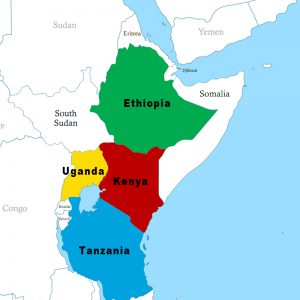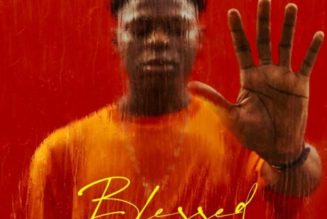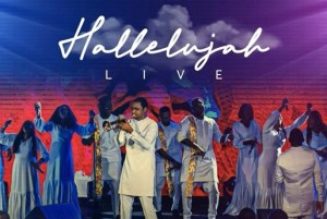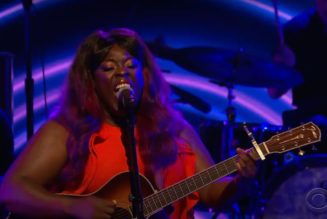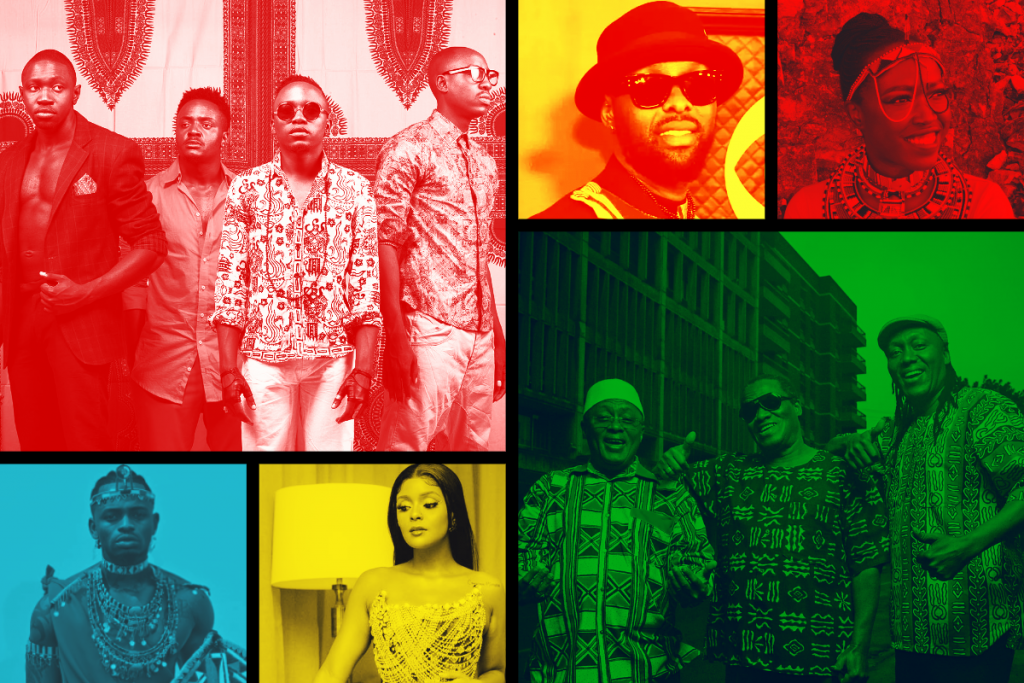
A few popular artists in East Africa, clockwise from top left: Sauti Sol, Eddy Kenzo, Nina Ogot, Them Mushrooms, Mimi Mars and Diamond Platnumz. Skott Bennett/STAFF.
The Grammys added a new category for 2024: Best African Performance. It’s a small step, as there are many dozens of musical styles on that continent, and just one prior category—Best Global Music Album—for them to fit. Latin music, for example, has six categories at the U.S. Grammy Awards.
Yet it’s significant because this category will expose Western audiences to more new music.
My family is visiting Tanzania in 2024, and I realized I knew very little about East African music. “Lion King” is set there—all the characters have Swahili names. Toto’s hit name-drops the Serengeti and Mt. Kilimanjaro. The great Freddie Mercury was born in Zanzibar, part of Tanzania. His childhood home is a museum. Zanzibar also hosts a popular music festival every February, drawing artists from all over Africa.
East Africa has a rich cultural history and diverse people. The music is not as well-known in the U.S. as West African music (from which the popular Afrobeats first came), North Africa (home of desert rock and blues) or South Africa (which has the most developed music industry on the continent), but it looks like that’s about to change.
The big reason for that change is growth in the industry, said Jacob Edgar, owner of Cumbancha, a Vermont-based record label and music publisher specializing in regional roots music from throughout the world.
“There’s a lot of music going on; it might not be being recorded as much or distributed as much,” said Edgar, an ethnomusicologist and record producer.
Edgar pointed at Ethiopia as a country where music has been exposed to the Western world, due largely to interest from European music producers who found it interesting. Several bands with no connection to Ethiopia—Edgar cited Texas rockers Khruangbin as a prominent one—have incorporated Ethiopian sounds in their own music.
“They draw a lot more on desert blues and Saharan music, but you hear a number of their songs have that sort of pentatonic Ethiopian flavor,” he said.
The reason West African music is more popular in the U.S. and the English-speaking world in general is a sobering and wholly predictable one: patterns of colonization and the slave trade.
“When we listen to West African music, it sounds a little more familiar to us because it’s actually at the root of our own popular music,” Edgar said. “It’s at the root of our blues, the root of gospel, even hip-hop. So all of these popular genres that we grew up listening to in the U.S. and from Europe have a very strong West African sound.”
But for the most part, East African music is less sonically familiar and a bit less accessible to a wider audience, he added. And in terms of the music industry of the more recent past, countries like Tanzania, Kenya, Uganda and, to the south, Mozambique, had fallen behind.
“That started to change as the tools required to both produce and promote music are becoming more accessible to people,” Edgar said. “You’re seeing artists emerge from those regions … as they’re accessible for the very first time.”
Music in countries like Tanzania has been influenced by the likes of Afrobeats from Nigeria, highlife from Ghana and soukous and Congolese rumba from the Congo. You’ll find musicians playing instruments like the kora, mbira (the thumb piano) and balafon. These days they’re likely to get added alongside guitar, bass and drums.
One of the most popular regional genres to emerge out of Kenya is guitar-driven benga, which like rock and roll emerged in the middle of the last century and was highly influenced on traditions of the past. Guitar is often paired with an eight-string lyre called the nyatiti, which originated in the region.
“It’s got its own unique style, and it’s sung in Swahili and other East African languages,” Edgar said.
Rock and American hip-hop are also popular, but music from home is king.
One of the earlier East African acts to catch on in a big way was Kenyan band Them Mushrooms, which started in 1972 as a band of five brothers, playing a mix of benga, reggae and taarab, which consists of Swahili poetry sung over typically string-led music. They also helped popularize a form of celebratory music chakacha, which is similar to taarab. Over the years, they added elements of hip-hop and soul music to their songs. They cite the likes of Kool and the Gang and Earth, Wind and Fire as influences.
The rootsy “Jamba Bwana” (“Hello, Mister”) was a lightbulb moment for Them Mushrooms, who in 1980 set out to write something it could play for tourists, teaching them Swahili. More than a decade later Disney and Elton John borrowed heavily from it on “Hakuna Matata.” It’s now sung throughout the continent, especially to tourists.
Them Mushrooms have released more than 20 albums and have created opportunities for other artists by starting a music resource center. Last month the group, led by Teddy Kalanda, celebrated its 50th anniversary with an extensive exhibit at a Nairobi museum.
“’Jambo Bwana’ is the first song we ever entered a recording studio to record,” said John Katana Harrison, one of the two remaining brothers performing with the group, in a video call from Nairobi. Them Mushrooms also consists of original member Billy Sarro Harrison, Katana’s son Kalume Katana Harrison, drummer Hassan Mandingo and guitarist Willie Mazera. Back then Them Mushrooms had four songs done, and recorded them as two single releases.
“We’ve had a good run with this song, being awarded with a gold, silver and platinum discs for excellent sales,” Katana said, adding that he’s proud of the group’s success but also upset that because of their lack of understanding of publishing and copyright laws, the band never properly retained ownership, and many others have this song as their own. “It makes us proud, but a lot of what is going on, we don’t earn from it because people are recording this song, left, right, center. … This song is magical because it spread all over the world.”
Kenya’s music infrastructure has improved since the early ’80s, when the country’s first copyright office opened, and it’s still growing, Katana said. It’s also become easier for musicians to get started.
“When we were starting out as kids, it was taboo for the young kids, age 14, 15, to indulge in music,” he said. “That mindset is almost disappearing, although we have pockets around the country. The instruments are easily available now, unlike back then. You get parents now taking kids to music school. You could hardly hear that back in the day. Things are changing, and it’s becoming easier for youngsters to join the music industry.”
While not all East Africa musicians are online, more of them are available to be found that way than ever thanks to platforms like TikTok and YouTube, Katana added.
The Tanzanian national arts council has identified five official music genres for the country: ngoma, dansi, kwaya, taarab and bongo flava, which was added in 2001. Unofficially, there’s a new kid on the block as well: singeli.
As an aside: From the formation of Tanzania as a new country in 1964 until 1993, recording and distribution of all music was managed by the country’s national arts council, which allowed only the four recognized genres at the time to be recorded or broadcast. Private recording studios or radio stations were not permitted until then.
Ngoma is traditional percussion-led dance music. Dansi is urban jazz or band music.
“Traditional music from various tribes in Tanzania, such as Sukuma, Chaga and Gogo, offer a glimpse into the diverse cultural heritage of the country,” said Musaddiq Gulamhussein, the owner of Easy Travel, a Tanzania tour operator and resident of Arusha City, the country’s gateway for safari trips. “These songs may feature traditional instruments and dance rhythms.”
Taarab is especially popular on the islands of Zanzibar (which merged with the former country of Tanganyika to become modern-day Tanzania in 1964) and other coastal regions of the country, he added. It features melodious tunes, poetic lyrics and traditional instruments. Some popular Taarab songs are about Zanzibar’s picturesque beaches and cultural heritage.
Kwaya is choir music, the most popular of which is gospel. It’s not always religious in nature. It can emphasize the beauty of the country and gratefulness for its blessings.
Bongo flava is the equivalent of Tanzanian pop music. The genre originated in the 1980s, influenced by reggae, R&B, hip-hop, taarab and dansi. More recently, it’s also incorporated aspects of Afropop, Afro-house from South Arica and singeli. Bongo flava songs often showcase the beauty of the country’s landscapes and attractions.
And singeli is a genre that only became popular in Tanzania’s largest city, Dar es Salaam, since the pandemic. It incorporates ngoma music and dance with an MC rapping over fast (between 200 and 300 beats per minute) taarab music. Each genre has its own subgenres, and a popular form of singeli is mchiriku.
“It represents the vibrant and lively atmosphere of the city,” Gulamhussein said.
John Katana Harrison, a Kenyan, credits Tanzanian musicians of the last century for becoming masters of the Kiswahili language by writing in such a way as to unite many types of people under the same language as well as sneak their lyricism by the eyes and ears of government censorship.
“They could sing about love or any explicit subject but in a very crafty way that it doesn’t sound offensive,” he said. “It’s happening even now with the younger musicians who are really on the scene because of the mastery of the Kiswahili language. They can take up any topic and sing it, whether good or bad, but in a very subtle way that it doesn’t sound offensive to their ear.”
In Tanzania, Diamond Platnumz is the biggest name in bongo flava. The 34-year-old artist, Naseeb Abdul Juma Issack also founded his own record label and media company. On the roots side, Saida Karoli is a celebrated traditional music artist, singing both in Swahili and her native Haya. As with many artists, her music often celebrates her homeland, and one of Diamond Platnumz’s early hits was a reworking of her song, “Maria Salome.”
One of Edgar’s favorite folk singer-songwriters from Kenya is Nina Ogot.
“What I really like about Nina is that she is very conscientiously looking at Kenyan traditional music as her main source of inspiration,” he said. “I think a lot of Kenyan artists in particular have overlooked some of their traditions, and she’s been doing a really good job exploring those traditional styles and integrating them into her sound.”
In kwaya (choral) music, the Kabusa Oriental Choir is one of the most successful acts around. The group is actually based in Nigeria, but many of their covers are of East African songs, or traditional-sounding covers of popular Afrobeats songs.
And few artists have crossed over to Western audiences quite like Uganda’s Eddy Kenzo, who like Platnumz now runs his own music entertainment company. He struck gold in 2014 with the first of several collaboration with dance troupe the Ghetto Boys and hasn’t looked back. Dance-enabling platform TikTok helped get his music out even more. He’s the first Ugandan artist to be nominated for a Grammy and the first to win a BET Award.
“His music is really great. It has a lot of traditional flavors, but it’s very contemporary and influenced by hip-hop and electronic music,” Edgar said.
In much of Africa, music serves much more more of a purpose than entertainment, and that’s no different in East Africa, Them Mushrooms’ John Katana Harrison said.
“There’s music being played at funerals, at weddings, at ceremonies,” he said. “Tribes like the Maasai, the Giriama, will use music for almost anything.”
And that continues to this day with modern music.
“What makes East African music special is its diversity, authenticity, and cultural richness,” said Rashida Ruwa, a Kenyan health writer. “The music in this region is made up of various genres and styles, blending different elements from different cultures to create a unique sound that represents the region’s identity. … Some artists use it as a form of expression that tells the stories of the people, their struggles and their wins! And the best part is it resonates far beyond our borders, so anyone from East Africa can listen to the music and relate to it regardless of their origin.”
Follow editor Roman Gokhman at Twitter.com/RomiTheWriter.

